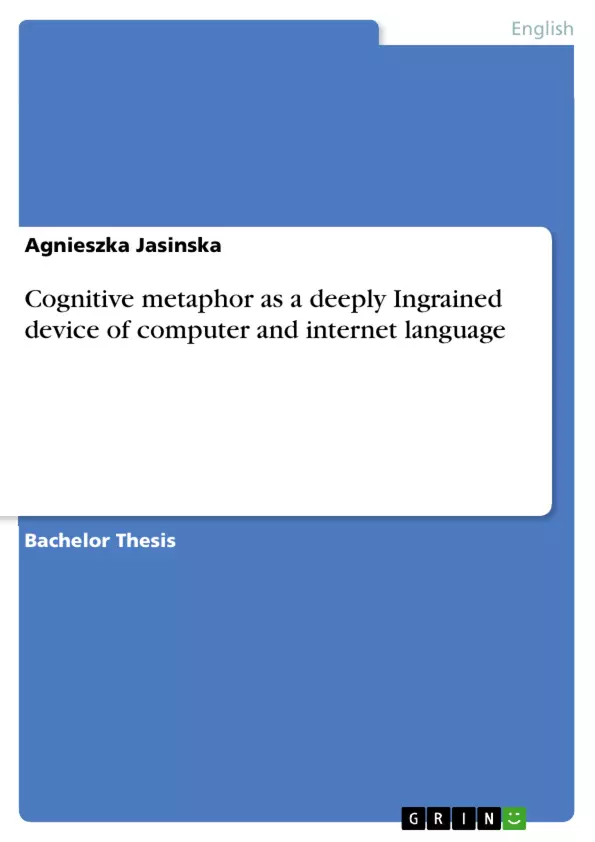
Cognitive metaphor as a deeply Ingrained device of computer and internet language
Bachelorarbeit, 2006
56 Seiten, Note: A
Leseprobe
Inhaltsverzeichnis (Table of Contents)
- Introduction
- Chapter One: Traditional versus cognitive view of metaphor
- 1.1 Etymology and aspects of metaphor
- 1.2 The Cognitive Linguistics view of the conceptual metaphor
- Chapter Two: Metaphor in the computer and Internet language
- Conclusion
- References
Zielsetzung und Themenschwerpunkte (Objectives and Key Themes)
This thesis aims to demonstrate the existence and usage of metaphors in computer and Internet language and analyze selected examples using the theory of cognitive metaphor. It explores the traditional and cognitive views of metaphor, providing a theoretical background for the practical analysis of metaphors within the context of human-computer interaction.
- The traditional versus cognitive view of metaphor
- The role of metaphor in user-friendly interface design
- Analysis of metaphors in computer and internet language
- The impact of conceptual metaphors on user experience
- Application of cognitive metaphor theory to computer and internet interfaces
Zusammenfassung der Kapitel (Chapter Summaries)
Chapter One: Traditional versus cognitive view of metaphor: This chapter lays the theoretical groundwork for the thesis by contrasting the traditional and cognitive linguistic views on metaphor. It begins by exploring the etymology of the word "metaphor," tracing its origins back to the Greek term "metaphora," meaning "to transfer." The chapter then delves into the traditional understanding of metaphor as a figure of speech, contrasting it with the cognitive linguistics perspective, which views metaphor as a fundamental process of thought and conceptualization. Richards' interaction theory is introduced, emphasizing the interaction between context and metaphorical expression, with concepts like tenor, vehicle, ground, and tension being defined and explained. The chapter sets the stage for the analysis of metaphors in computer and internet language presented in the subsequent chapter by establishing a robust theoretical foundation for understanding the nature and function of metaphor.
Chapter Two: Metaphor in the computer and Internet language: This chapter applies the theoretical framework established in Chapter One to analyze the use of metaphor in the language of computers and the internet. It examines how metaphors shape the design and user experience of computer interfaces and online environments. The chapter likely analyzes examples of metaphors used in graphical user interfaces (GUIs), online help systems, and other digital interfaces to demonstrate how they facilitate user understanding and interaction. It might also address counterarguments, such as Cooper's critique of metaphor in user interface design, and discuss the potential limitations and drawbacks of relying on metaphors in creating user-friendly technology. The chapter would ultimately showcase the pervasive nature of metaphor in shaping our understanding and interaction with technology.
Schlüsselwörter (Keywords)
Cognitive metaphor, conceptual metaphor, computer language, internet language, user interface design, graphical user interface (GUI), human-computer interaction, metaphor in technology, cognitive linguistics, user experience.
Frequently Asked Questions: A Comprehensive Language Preview
What is the purpose of this document?
This document provides a comprehensive preview of a thesis examining the use of metaphors in computer and internet language. It includes the table of contents, objectives and key themes, chapter summaries, and keywords. The preview aims to offer a structured overview of the thesis's content and methodology.
What are the main topics covered in the thesis?
The thesis explores the prevalence and function of metaphors within the context of computer and internet language. It contrasts traditional and cognitive linguistic views of metaphor, focusing on the application of cognitive metaphor theory to analyze how metaphors shape user interface design and user experience. Specific areas of focus include the role of metaphor in user-friendly interface design and the impact of conceptual metaphors on user interaction with technology.
What are the key theoretical frameworks used in the thesis?
The thesis primarily employs the theory of cognitive metaphor, contrasting it with the traditional view of metaphor as a mere figure of speech. The concept of metaphor as a fundamental process of thought and conceptualization is central to the analysis. The document also mentions Richards' interaction theory, highlighting the interplay between context and metaphorical expression (tenor, vehicle, ground, and tension).
How does the thesis analyze metaphors in computer and internet language?
The thesis analyzes examples of metaphors used in graphical user interfaces (GUIs), online help systems, and other digital interfaces. This analysis aims to demonstrate how these metaphors facilitate user understanding and interaction with technology. The analysis also potentially considers counterarguments, such as critiques of metaphor's overuse in interface design.
What are the chapter summaries?
Chapter One contrasts traditional and cognitive linguistic views of metaphor, tracing the etymology of "metaphor" and establishing a theoretical foundation for the analysis. Chapter Two applies this framework to analyze the use of metaphor in computer and internet language, examining its impact on user interface design and user experience, and potentially addressing limitations and drawbacks of relying on metaphors in technology.
What are the key terms or keywords associated with this thesis?
Key terms include: Cognitive metaphor, conceptual metaphor, computer language, internet language, user interface design, graphical user interface (GUI), human-computer interaction, metaphor in technology, cognitive linguistics, and user experience.
What is the overall goal of the thesis?
The thesis aims to demonstrate the existence and usage of metaphors in computer and internet language and to analyze selected examples using the theory of cognitive metaphor. It seeks to contribute to the understanding of how metaphors shape human-computer interaction and user experience.
Details
- Titel
- Cognitive metaphor as a deeply Ingrained device of computer and internet language
- Hochschule
- Uniwersytet Marii Curie-Skłodowskiej w Lublinie (German Studies)
- Note
- A
- Autor
- Agnieszka Jasinska (Autor:in)
- Erscheinungsjahr
- 2006
- Seiten
- 56
- Katalognummer
- V89167
- ISBN (eBook)
- 9783638030731
- ISBN (Buch)
- 9783640522798
- Dateigröße
- 694 KB
- Sprache
- Englisch
- Schlagworte
- Cognitive metaphor computer language internet language cognitive metaphor
- Produktsicherheit
- GRIN Publishing GmbH
- Preis (Ebook)
- US$ 19,99
- Preis (Book)
- US$ 28,99
- Arbeit zitieren
- Agnieszka Jasinska (Autor:in), 2006, Cognitive metaphor as a deeply Ingrained device of computer and internet language, München, Page::Imprint:: GRINVerlagOHG, https://www.diplomarbeiten24.de/document/89167
- Autor werden
- Ihre Optionen
- Vertriebskanäle
- Premium Services
- Autorenprofil
- Textarten und Formate
- Services für Verlage, Hochschulen, Unternehmen

- © GRIN Publishing GmbH.
- Alle Inhalte urheberrechtlich geschützt. Kopieren und verbreiten untersagt.
- info@grin.com
- AGB
- Open Publishing
Der GRIN Verlag hat sich seit 1998 auf die Veröffentlichung akademischer eBooks und Bücher spezialisiert. Der GRIN Verlag steht damit als erstes Unternehmen für User Generated Quality Content. Die Verlagsseiten GRIN.com, Hausarbeiten.de und Diplomarbeiten24 bieten für Hochschullehrer, Absolventen und Studenten die ideale Plattform, wissenschaftliche Texte wie Hausarbeiten, Referate, Bachelorarbeiten, Masterarbeiten, Diplomarbeiten, Dissertationen und wissenschaftliche Aufsätze einem breiten Publikum zu präsentieren.
Kostenfreie Veröffentlichung: Hausarbeit, Bachelorarbeit, Diplomarbeit, Dissertation, Masterarbeit, Interpretation oder Referat jetzt veröffentlichen!
- GRIN Verlag GmbH
-
- Nymphenburger Str. 86
- 80636
- Munich, Deutschland
- +49 89-550559-0
- +49 89-550559-10
- info@grin.com
-









